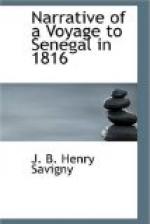(Signed)—The Editor of the Journal des Debats.
This certificate was put into the hands of M. —— and by him presented to his excellency, who, however, did not appear satisfied, because this certificate, though it proved, that Mr. Savigny was not the person who had rendered public the history of our adventures, threw no light on the means by which the manuscript had become known to the editor. One of the principal persons in the office, having signified to him the opinion of his excellency, who found this justification insufficient, Mr. Savigny again had recourse to the editor of the journal, who gave a second certificate as follows.
“I certify, that it is not from Mr. Savigny, that I have the details inserted in the Number of the 13th of September, but from the office of the Minister of the Police.” After this new proof, it was no longer doubted, but that Mr. Savigny had been the victim of an indiscretion, and he was told that he might return to his post. He therefore left the capital, after having experienced many vexations; but those, which the publication of our misfortunes was to cause him, were not yet at an end.
The English translated the details contained in the Journal of the 13th of September, and inserted them in one of their Journals which reached Senegal. In this amplified translation, there were some pretty strong passages, which were far from pleasing the governor, and M. ------, one of the officers of the frigate. They perceived that there was but one means to combat the narrative; this was to endeavour to make it believed, that it was false in many particulars. A report was therefore drawn up at St Louis; it was brought to Mr. Correard to be signed, who, after perusing it, refused, because he found it contrary to the truth. The governor’s secretary came several times to the hospital, to urge him for his signature; but he persisted in his refusal: the governor himself pressed him very earnestly one day that he went to solicit leave to depart; he answered, that he would never consent to sign a paper quite at variance with the truth, and returned to his hospital. The next day, his friend, Mr. Kummer, went to him, and invited him to return to the governor’s, in order, at length, to sign this paper, because he had been informed, that if he persisted in his refusal, he should not return to France. These gentlemen, must therefore, have felt themselves deeply interested, to be reduced to employ such measures towards an unfortunate man, exhausted by a long sickness, and whose recovery depended on his return to Europe, which they thought not to grant him, except on condition of his signing a false narrative, contrary to what he had himself seen; for one paragraph was employed to prove that the towrope had broken; could he sign it, who was himself an eye witness, and who had been assured by more than twenty persons, that it had been made loose. Besides this falsehood, it was stated one passage,




